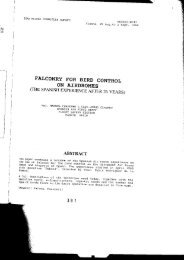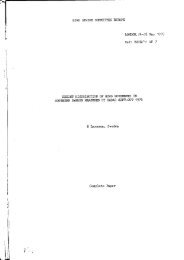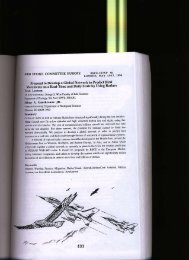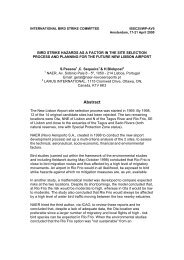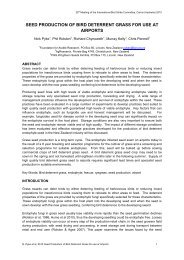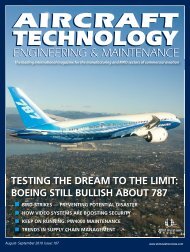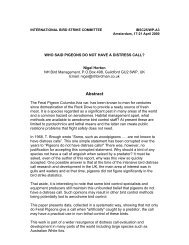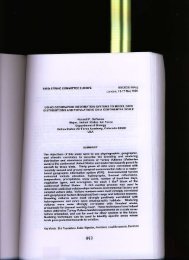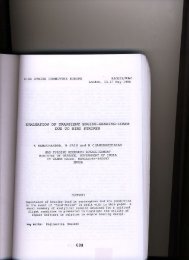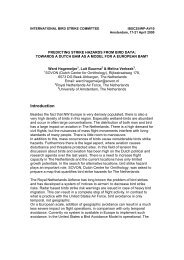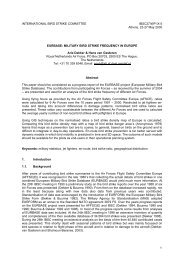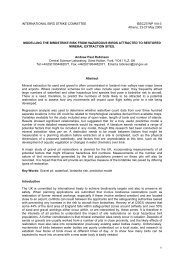Bird movements aro - International Bird Strike Committee
Bird movements aro - International Bird Strike Committee
Bird movements aro - International Bird Strike Committee
You also want an ePaper? Increase the reach of your titles
YUMPU automatically turns print PDFs into web optimized ePapers that Google loves.
BIAD STRIKE COMMITTEE EUROPE<br />
ascE23/wP 57<br />
London, 13 -17 may 1996<br />
BIRD MOVEMENTS AROUND AIBPORTS: A CRITICAL ISSUE tN THE<br />
SPECIFICATION OF AVOIDANCE SYSTEMS<br />
Luit S. Buurma<br />
ANLAF Flight and Ground Safeiy Division<br />
Natural Environfr ent Section<br />
P.O. Bor 20703<br />
2500 ES The Hagle<br />
SUMMAAY<br />
ouant iylns, quarilying and predlctins low levcl b rd 'novements is the key issue<br />
hamDerino the certifcation or bnd sfiike prev€ntlon mc.sures i. rhe conrro zone of<br />
airports as we as en route . Bnd conrol at rhe runway tsclf is atre.dy succestu at<br />
many ai.ports. Less w de spread, and limn€d to m tary aviat on, blt technica y<br />
speakinorpclor mproveme.t,6r€ larse scale warn.g sysrems ndicatlng mass bnd<br />
mrgranon. Howcver, the'botrom up' and top dow.' .pproach roqether do by lar not<br />
solve.ll bnd strike problcms A geoo.aphlcalcomparson or the (tow tevet) atrttude<br />
drstriburion ot milltary b rd strlkes lrom EUFaASE indicat.s a missi.g li.k, jLsr ourside<br />
vsLa range but also below the covefage of most radars. Thls risk ls posed by tocat bnd<br />
lrghts ov€r up to some tens ol kilomerers especla ly in coasral and wertand areas.<br />
l.tesratcd.adar a.d visual obscrvations in The Netherlands show th.t a so a signiic.nr<br />
part or onq distance nigratory I ishts may occlr .1 low evel, evcn ar niqht. Locat and<br />
migralory flghts may accumulate along topos.aphical baiiiers or leading lines ar<br />
ocaiions considered lor anport consrrucrion.<br />
Thls prescntatio. is a plee Jor the c assiiicarion of rhese complex problems. This sholtd<br />
happen rn slch a manner that existing ornitholoeica know edOe w help to develop<br />
r!es oi thumb to be used in intearalcd bnd avoidance systems. There are iund6menial,<br />
psycholoOicalas wc as polticalreasons why operatio.. bnd predlctio. models shoull<br />
bc backed Lp by bnd detection devces. Problcms with wild ge€se winrering in The<br />
Nelherlands m:yserve as an example.<br />
Key Words: Slalistics, M itaiy Aviatio. Locallr,lovements, Brd Popu atons, Deteclion, Radar<br />
5{3
sr<br />
li<br />
t;<br />
t!<br />
(,<br />
.{'<br />
rfigrfr<br />
ao<br />
c)<br />
,r<<br />
U'<br />
lt<br />
.=<br />
.cr<br />
(E<br />
a<br />
o<br />
bS<br />
o<br />
o<br />
CL<br />
o)<br />
E<br />
.=<br />
=<br />
$<br />
lrJ<br />
U)<br />
m<br />
(E<br />
:)<br />
IIJ<br />
o<br />
(9<br />
ol<br />
o<br />
o<br />
N<br />
o<br />
o<br />
+<br />
o<br />
o<br />
G)<br />
o<br />
o<br />
o<br />
o<br />
o<br />
(1ee1)<br />
sseJc opnlglv<br />
t<br />
tt<br />
o<br />
o<br />
o<br />
t!<br />
C)<br />
o<br />
o<br />
5{4
f<<br />
(t)<br />
Becker (1996) summarized the discussio. n the Low LevelWG on 'en route<br />
b rd st. ke preveniion d!r ng thc last ten years. He is perfectly right in his<br />
conclusion that we should hcad lor an lntegrated approach, combi.i.g<br />
geographical, b olog cal, weather and radar data . My staremcnr ol today s rhar<br />
we on y can make such inte9rated prevention operat onaly stable whef we<br />
succeed n classifvino and subsequenty standardislna the d ffc.€nt prevention<br />
eements. In olhcr wo.ds: we must develop a.d speak ihe same ang!age in<br />
order to communicate abour the .redictab c and non o.edic.r"ble aspects of the<br />
bnd strlke risk. Predictab e risks arc in principle open ior.e iiiablc prevenlive<br />
measures rcsult ng in a quanrlflab e risk reduction. A!t also the .ema ning .on<br />
pr€d ctab o types of b rd danger can be brought under control to a ce(ain<br />
extcnt, Remote sensifg of bird movcrncnts has a proven porenrial in rea 1me<br />
warning systems (B!urma& Brldeicr 1990, Lcshem 1994). Th s p.per aims ro<br />
stim! ate berter comm!n cat on on the mproveme.i of nvoid..cc sysrems by<br />
Jocussing on the crillca iss!e ol ow evel bira ilgfr,<br />
Evidence from military stalistics<br />
(,<br />
o<br />
o<br />
B rd control at the runwav itself is a ready s!ccesful ai many airporrs. Less<br />
wde spread, and llmred ro mi(ary aviation, b!r techn cally speakng ripe for<br />
mprovement, are large sca c warning sysrems ndic.ri.a mass b rd migrario. n<br />
h gher airlayers. However, the 'bonom l]p'a.d 'lop.down'approach rogerher do<br />
by f.r not solve all bird strike problems. A gcographicalcomparlson ol rhe (low<br />
levc ) altitude disrribution of mllilary bird strikes from EUFBASE indrcares a<br />
s!bstantial p.oblem, jusr outside visual range but .lso below lhe coverage of<br />
mosl .adars: iigure 1. Thls risk is posed by loca b rd f ights over up to sorne<br />
tens of kilometers, especia ly n coaslal and wcaand arcas.<br />
<strong>Bird</strong> srrikes may i.dic.re rhe yeat rcLn.l avercge anitude disrriburron oi bnds<br />
(almost) inespective ol the time spend and disrance covered by ai.cratt €t<br />
d llerent he ghts. Th s s on y thc casc whcn wc sclccl so ca led 'local strikes<br />
e.g. d!rlng Iake off, landrng and overshoot (Buurma 1984), D!rlnlt these ilghl<br />
phases the 1i!ht path oi the :i.craft has a lixcd ang c 1{) the ea(h s!riace. The<br />
Europea. Miirary B rd St ke D.iab.se (EURBASE, see also Bu!rma & Dekker<br />
1996) olfcrcd thc posslb lity to compare this selecrion (N=2582) lrom iive<br />
wcst-c!ropean ai. lorces, In f g!rc 1 wc f ttcd curves rhrou!h the a t tudc<br />
dlsrribuio.s in 100 ft classes. The resu rs look .ather slmular, bul when we<br />
nspecrhe curves closer i.e. at 3o0 it (ca 100 m) and comparc the rwo<br />
exvemes, GAF and BAF, we f nd thal the UK birdsrrikes at thls hcicht are rhree<br />
timcs mo.c frcquenthan thosc ovcr Gcrmany. The concluslon is therctorc that<br />
ihe FAF nol only suffcrs trorll a h gher bird slr ke rate (see Bulrma & Dekker<br />
1996), blt las the curves are percentua ) a so from a d lferenl lype ot risk than<br />
the GAF. Appareft y the blrd popu allo. aDove and <strong>aro</strong>und the British lsles,<br />
which ls domlnated by coasrar and wel and species, fles hi!hcr and ai a larger<br />
\43
546
sc€le than thc average blrcl .bove the E!ropcan mainla.d This becomes evcn<br />
more obvio!s whe. we check thc oilrer air forccs a.d bird d str b!tion maps<br />
Evidence from bndlstlike) distribution maps<br />
Fi.stly, Jigure 2 shows a parI of the BSCE birdrisk map lndicatins zones oi ight,<br />
moderate and heavy b rdstrike r sk. This i.ternario.aL map, deve oped n the<br />
Sevenlics under the lcadership of Dr' J H ld, is bascd on best profcss onal<br />
iudgemcnt abo!I 'rotal bird mear densities' lr cLear v indicates how ihe marn<br />
bid areas are concenlratcd in the f at wcllands along thc coast a.d ln I ver<br />
delra's. lt is also obv ous that RAF and RDAF are mostlv contionted wth these<br />
blrd.ch zones whilc FAF 6nd GAF {n this o.der) have rhelr ow levelilving over<br />
the lcss risky ln and, where wetla.d specles are much sca.cer. This sequencc ol<br />
air lorccs i!lly iits with tlie seq!encc of lhe curvcs in iig!re I<br />
Thc co(e arlon betwccn the type of c!rve and thc air fo.ce llviFg area can bc<br />
deta led fu(her when wc ook al lhe RNLAF, having a posltlon in the m dd e, on<br />
the map as wcl as amofg thc altitude clrvcs The centrc oI I ving act vllY of<br />
this a r force s n the SE part of tlie country, avoiding thc dc.se human<br />
populat on nr rhe fertile pol.lers below sc. evel in thc wesr' Fig!rc 3 (top)<br />
shows thc bnd sanctlar cs and b rd str ke r sk map itom lhe AIP Ncther ands.<br />
The clashed Ine denotes tlre bou.dary betwccn heavv and moderat€ risk irom<br />
i gure 2. Five a rtrases are plottcd as rectang!lar black figurcs The lavcrage)<br />
helghi of cach symbol glvcs the bird strikc r.te as w€Ll 6s the trend over the last<br />
10 ye€rs. Goin! from ESE to WNW rhe ilve bascs show a. Incre.se In average<br />
local b r.i sfi ke .ate co(espondlng to the i.cr€asc ln ge.eral bird de.sitv. The<br />
salest base .ear the border wnh GernanY (Twentc AFa) and thc trase wlth the<br />
h ghesr b rd str ke r.t o lLec!warden AFB) wcre subjectcd 10 .n equal v rnlense<br />
bkd sr.ike p.cvcnlio. p.o!..m. Ai TW we wcrc zble ro app v hab ial<br />
mo.iif catio. slccesiu ly (Dekkcr& Van der Zcc 1996), but al LW we st ll have<br />
ro aeve op:ddit onal preventlon me.s!res Herc the nearbv waadensea/ o.e Dr!<br />
nature arca, generates tidal mass movcmenls oi birds far .Land Fu(her, thc<br />
very fen le grass ands ot the rcgion <strong>aro</strong>!nd thc base atiract big numbcrs or<br />
'culturc<br />
following' spec cs among !!lls, d!cks and waders A spcc al and<br />
grow ng prob em are geese n winler (see b€ ow)<br />
Thc problems at LW AFB correspond w th rhose at Schiphol alrporl near<br />
Amsterdam. Qf course both a rile ds have Ju I rime Airpo( <strong>Bird</strong> Coflrol bul a so<br />
the spatlaL planni.g a.d bird attract.g develop'ne.ls n a certarn arca qq!0q<br />
thc a rport must bc considered (Klavcr 1994, B!!rma 1994a). The prescnl<br />
EUFBASE dala do rellect the f.cr that ocal bird movemenrs n wclla.d areas<br />
!s!ally occur at such a scale that struct!ral meas!res a.c polillcallv mpossib c<br />
This is becominO vcry apparent ln the present Duch debat where to crcate a<br />
second major airpo(. All possible locar ons {black dots with white asterlsk) arc<br />
.ear important b rd sa.ctuaries or in zones wherc m g.atorv birds rend to<br />
conccntrale. Flgure 3 (bottom) il!srrai€s thc classical v cw on au!mn<br />
migratio. {taken from T nbergen 1949). Our own .adar sr!dv nc.r Hook ol<br />
Holland (Buurma& Va. Gasteren I989) shows an cven molc hle.se tlvifg<br />
547
d'---\rdusirir<br />
548
activity parallello the coastline over land and sea in a zone ot over 1O km wide.<br />
It occurs also at nighi, and includes loca and regionalrnovements. At present<br />
the discussion focusses upon creating new land in the North Sea along the<br />
coa$ (figure 4). The complication is not only that such hugh inffastructural<br />
works usually overlap with the birds flyways bur a so that these wofks atmost<br />
always create new bird concentration areas themselvesi<br />
Local fe€ding and roosting llights tollow patterns and time schedules that can<br />
be measured and to a reasonable extent be predicted. A wealrh of biotogical<br />
knowredge on the behaviour of most bird species is already available in the<br />
literature. lt should therefofe be possible ro model the spatial and temporal<br />
aspects of the fying behaviourof the main catesofies ol common blrd species.<br />
The most cruclal aspect is fLying height, which wil be dependent of wlnd,<br />
thermal conditions, type of landscape and especlally dlsrance to be covered.<br />
llustraiive is the growing winrerpopulation ol the Whire fronled goose in the<br />
vicinity of Leeuwafden AFB (figure 5). NE of the city of Leeuwarden rhere is a<br />
3ke area (black)where 40.000 white fronts gather for the ntght. They feed on<br />
the grasslands in the su(oundifgs and reg!larly cross the flighr path ol {mosrty<br />
The number of White fronied geese near Leeuwarden have grown fiom 2.000 in<br />
ihe Sixties to the present figure. This parat ets the rotaL n!mber w nrering in The<br />
Netherlands which grew to almosr a millon indlviduals. However, this does nol<br />
imply that we can conslder the sp€cies as a pest species tn the wav Attan &<br />
Feare 1994 did while discussing cont.o measufes aga nsi {era Canada goose,<br />
The fecent Concorde and AWACS accidents will undo!btly invoke a campalgn<br />
against resident Canada geese <strong>aro</strong>und akports- Blt our Whire fronts are<br />
migrants trom an hugh eurasiatic breeding range and subjed oi concern in the<br />
international conservation debat (Aubrecht 1994). Sporls hunting may be a<br />
scanng instrument when planned spalially in a proper wav. But so far we do not<br />
know how rhis affects the daily f ight pattern three dimensionatty, In case rhe<br />
birds cross rhe huni ng area at higher flight levels the birdstrike .isk may<br />
increase in stead of decreasel<br />
Given the growth of the h!man population, the value of €xisting nature res€rves<br />
increases and parallel with th s the populariry of birds, Moreover, ihere is fast<br />
growing political basis for creating'new naru.e'in combinarion with integral<br />
wat€rmanagement {B'rurma 1994a). Consequently, the political basis for<br />
measures to reduce total poplJlation size of a certain blrd species has almost<br />
disappeared. This fact togerher with the findlng rhat the scale or tocat and<br />
regional bird movemenls is much bigger than often rhought, m!st lead to<br />
'sharing<br />
the ak'as a rewarding prevention option. This brings us back to the<br />
aim of this paper: the future of bird avoidance svstenrs.<br />
550
adar in avoidance systems<br />
In figure 6 the curves of figure 1 are combined with attitudtnat ranges ot b rd<br />
control: en foute, <strong>aro</strong>und and on anpons. Avoiding birds in the air is difftc!h<br />
because many bird <strong>movements</strong> occur betow rhe coverage of most tong range<br />
surveilance radars {stippted) and just above the acquisition .ange of rh; visual<br />
observer (shaded). To make ir even worse. tow tevet btd fying activtry is oflen<br />
in big flocks as food rinding is a very sociat affair, especia y i; wefland a.eas<br />
where water rabte dynamics creares a ftuctuating and palchy availabitiry of<br />
food. A thorough map/calendar approach is of course the lirst srep in pianning<br />
new airpo(s or aircrait flying routes. aut this information atone is too static f;r<br />
day-to d€y bkd strike prevention. For each headache species the daity and<br />
seasonal flying partern shoutd be known. In principte a tot of bi.d activity can be<br />
predicted by a dynamic modet fed bV certain environmentat parameters, aut<br />
scientific generalizations are lsua ty not enough to predict how each species w I<br />
adapt to specific localconditions. Additionat rutes of thumb about spatiat fying<br />
behaviour in reation to wearler, topography etc. are neeneo.<br />
l. practice the onty ,rnodets,ihai do exist are very experienced b rd contro|ers<br />
gvinglheir'best profess onatjudgeme.r,_ Howevef, this iype of antictpation is<br />
primarily based on whar can be mentaty reconsrruct€d from visua observarion.<br />
This is usually imlled to rhe a rport itsetf and 10 the towest 5O meters (Buu.m.,<br />
Lensink & Linnartz 1986). Bur even he.e a big bird fock may sudenty appear.<br />
As noi all blrd controtters are eqlalty experienced and atert, and as they cannot<br />
overvrew the whole aiiport, ihere is a gap in tho markel for detecl on devices<br />
oaseo on remote sensrno such as radar.<br />
radar in avoidance systems<br />
The above mentioned gap in the marker is growing surely but s owty as rong as<br />
we are not at)re to quantify rhe bird strike risk betler and to show convincingty<br />
the amo!nr of risk reduction. Air traffic conlro ers do not wish ro accept<br />
addillonal responsibilities when the btrd information is nor very ctearty indicared<br />
and well derined. Obviousty, not every singte smaI or medium sized b rd can<br />
kept under controt. Thus, rhe equ pment shou d be abte 10 tndicate whether the<br />
amount ot bird meat in a cerlatn air vot!me exceeds a ce(ain agfeed vatue.<br />
Figufe 6 is a propos:lro reduce the many options or apptying remole senstng<br />
into three altitude/scate ctasses on the basts of rhe spaital disrribution oi b rd<br />
slrikes. ls!ggesr the fotowng terminotogy,<br />
A. 2-D on airoort bird flock deteciton Certain ground radars do have the<br />
capacity to monitor birds or cou d be adjusred 10 do so {schaefer 1969). Given<br />
the limiled range needed 6tso off-the shelve marine radars with a reptaced<br />
anlenna, to .a ow t\e bear and ircrea\e qdin, mrght be .porred. Ihe n a n<br />
p oD em 6 grou-dctLtrer r"d-cr o1, bJt sopli\r.carFd new techro,ogy is abte to<br />
solve this satisfactority.<br />
i\2,
avova cNn<br />
vl<br />
C'<br />
.t(<br />
o<br />
avovS 08la<br />
.//= =s= =<br />
as -l'l<br />
.o<br />
o<br />
o (,<br />
o<br />
IL<br />
s8vova av^ 's3un9H xroNl<br />
o o_<br />
o<br />
00<br />
o<br />
@<br />
o os<br />
o<br />
ol<br />
(taor) sselc apnllllv
a. 3-D airport vicinitv bird co.irot Thts has been adopted during rhe tgth BSCE<br />
meeting in Madid (see Buulma & Brudere. j99O) as rhe ideats;tution. The<br />
radar needed should be abte ro trace individuat bird itocks interfering with<br />
aircraft flight pathes tLow Levet Search, LLSe) as we as to monrtor bnd<br />
densities by volume scanning (High Leveisampting HLSa) (Buurma 1994b).<br />
C. <strong>aro</strong>e e miorir,on :qa<br />
monrori.o Vaaous rada,s can be uspd ro ger inde\<br />
I gures or rarge scate bird migrarion, M,hrarv air dere.se ano ai, lfa c coni.ol<br />
radars are atready used for many years in the west european birdtam system.<br />
Modern weather radars and wind profiters offer cha|enging new possib tities.<br />
The main problem stiJt is catibration.<br />
Allan, J.B. & C.J.F€:re {1994). FeratCanada geese (Branla canadensis)as a<br />
hazard ro aircraft in Europer options for management and control.<br />
aSCE22/wP3:25,42.<br />
Aubrecht, G. (1994). Waterbird and wettand conservaiion - |WRB,s qtobal<br />
nelwork and rhe cu,rent sta.e o, rhp i.rp.na.olat R"msar Co;eltion dnd<br />
Bonn Convenrion. BSCE22tWp6:55-62.<br />
Becker, J. (1996). How to get retab e information on the bird strike .isk<br />
BSCE23/WP 8 hhis meeltnol<br />
Buurma, L.S. {1984'. KeV facrors deler. n.ng btrdsr1,e ar d ricts. J. o.Avration<br />
Saferv, Vol 2 nr 1:91-'l07<br />
Buurma, L.S. (1994a). Superab!ndance in birdsrrrenos, weitands and aviation.<br />
aSCE22/WP4:43-50.<br />
B!urma, L.S. (1994b). High bird densiries assessed by radar, a ROBTN report.<br />
BSCE22lWP32:223-242.<br />
auurma, L.S. & B.Brudeier 0990). The apptication of radaf ror bird srrike<br />
reduction. aSCE20/Wp36:273 445 (,radar bookref ).<br />
Buuma, & A. Oekker (1996). ''1.S.<br />
EUBBASE: potenriat lessons fiom mitirary bird<br />
strike statistics. aSCE23AVP6 {rhis meetino).<br />
BLUrma. L.s. & H. v€n -casrere.<br />
{19891. M,gr<strong>aro</strong>i,i b ros a.d obctac es atong<br />
-<br />
tne coasr of the Dutch province Zuid Holand, RNLAF,report, 1j7 pp.<br />
Buurma, t.S., R, Lensink & L.c. Linnartz (1986). Aftitode of di!rnat broa; ,ronr<br />
mrgratron over Twenrej a comparison of rada. and visual obseruations in<br />
O.iober 1984 | n Dur.h. I 19. su-narvJ. I rosa 59:169.182.<br />
DeLke . A. & F.t-. van de, Zee {1996J. B ros a-d s,.sstdld on a rpo,r\.<br />
BSCE23/WP30 (this meeting).<br />
Klaver. A {t9-94j Ndrure d g.,L sa.e.y a conrjover5y.<br />
BSCE22/WP5:51-54<br />
Leshem, Y. (1994). Twenty,three years of bird strike danrage in the tsraet Air<br />
Force 1972 1994. BSCE22twp22t 193-.t62.<br />
Schaefer, G.W. (1969). An airport bird derection radar for reducing bird hazards<br />
_.<br />
to arcraft. Wond Conf.on aird Hazards ro Aircratt, Kingsron, Caoada.<br />
Tinbergen, L. (1949). Vogels onderweg. Schetema & Hotkema, Amsrerdam.<br />
554



